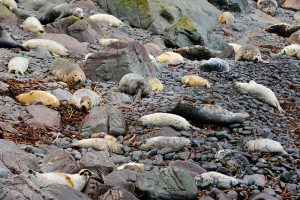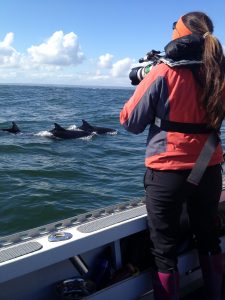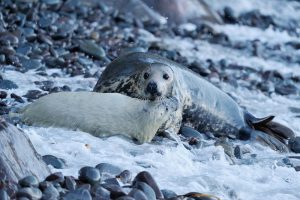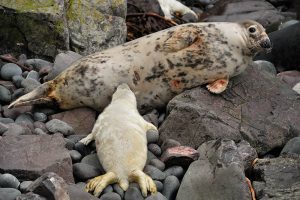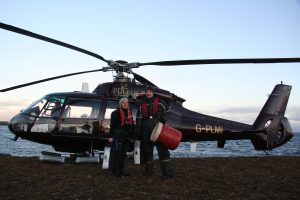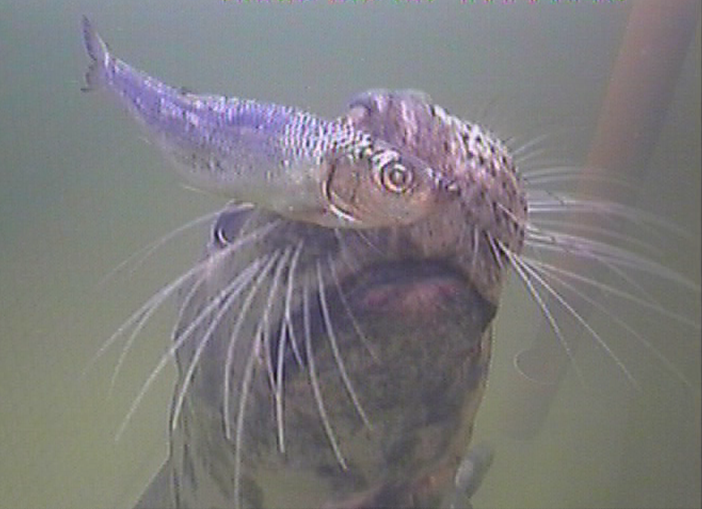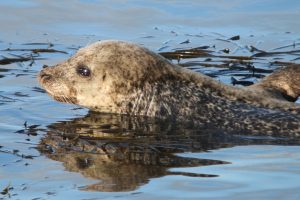Discovery: Population and Foraging Ecology
We study the population dynamics (the trends in the abundance, age-structure and distribution) of a wide range of marine mammal species from the small and large cetaceans to the phocid seals in UK waters. Determining changes in these dynamics is critical to understanding the biological and environmental factors controlling them.
Alongside this is our interest in how marine mammals, of all species, interact with their environment, through their foraging and feeding strategies, and the constraints on those strategies. Linking these two arms of ecological research will help us determine the major drivers of population change.
Abundance
Marine mammals are difficult to count as they spend most of their lives in or underwater. Seals must return to land to rest, moult and to reproduce but cetaceans remain at sea for their entire lives. A primary goal for many studies is simply to know how many animals there are and where they are to be found. For most marine mammals, it is therefore difficult to obtain a precise estimate of the total population size. Instead, some component of the population is surveyed and statistical models are used to convert this component into an estimate of overall population size.
Results from abundance estimation are used in population modeling to understand how and why animal population sizes changing. Such changes may have important conservation implications. Accurate abundance estimates are also an essential factor in assessing industrial impacts and fishery interactions.
Callan Duck, Chris Morris, Debbie Russell, Phil Hammond, Nora Hanson
Distribution
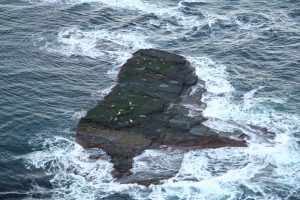 Understanding the distribution of marine mammals helps us to understand their ecology: why they choose to be in one place rather than another. There are numerous ways in which we make use of distributional data, and the results inform many other areas of work within the Sea Mammal Research Unit and elsewhere.
Understanding the distribution of marine mammals helps us to understand their ecology: why they choose to be in one place rather than another. There are numerous ways in which we make use of distributional data, and the results inform many other areas of work within the Sea Mammal Research Unit and elsewhere.
A large part of SMRU’s work has historically revolved around the instrumentation of marine mammals, using a variety of telemetry devices to study both their underwater behaviour and their distribution.
The distribution of marine mammals has also been studied extensively by the use of sightings data, and more recently by the use of passive acoustic monitoring. Sightings data collected from platforms of opportunity and from dedicated surveys have been combined, for example, to produce maps of cetacean distribution based on the number of animals seen per hour of observation. Dedicated surveys are able to generate estimates of absolute abundance by geographical area, enabling trends in density through time to be analysed, with obvious conservation and management benefits.
Seal distribution is routinely monitored photographically by the Sea Mammal Research Unit through annual aerial surveys of haul-out sites and breeding colonies. Distribution data are also used in population modelling to understand the linkages between breeding groups, and the ways in which populations are dispersed.
Callan Duck, Chris Morris, Sophie Smout, Debbie Russell, Doug Gillespie, Gordon Hastie, Nora Hanson, Sascha Hooker, Phil Hammond, Sonja Heinrich
Reproduction and Survival
Marine mammals face particular challenges to successful reproduction because of their life histories, ecology and size. For many marine mammals, the locations of foraging and breeding areas may have important influences on how reproduction occurs. The cumulative success of individual reproductive efforts is one of the fundamental demographic drivers for the make-up and abundance of a population, therefore it is critical to have a broad understanding of reproduction.
Estimating survival for different age-classes within populations is also critical to predicting the dynamics of populations. Equally important and challenging is understanding the factors that can affect the survival probabilities of different age-classes, particularly in younger animals in which mortality rates are often high. Photoidentification and mark-recapture modelling is one of the methods we use to estimate fecundity and survival in different species.
Population Modelling
Understanding how populations of marine mammals change through time and space is an important goal of marine mammal science that has a direct impact on conservation policy and practice. More often than not, however, the data that we can collect through surveys and studies of animals in the wild only gives a very restricted view of what the entire population might be doing.
To make inferences from what we have observed to what might be going on for an entire marine mammal population often therefore requires some degree of statistical modelling. We use a variety of modelling approaches for example, Bayesian state-space population models are used to determine total population sizes from counts of grey seal pups from air surveys.
Population Genetic Strucutre
Population genetics has allowed us, in collaboration with molecular ecologists and geneticists, to determine the population structure of various marine mammal species, including grey seals, harbour seals and humpback whales.
The increasing advancement of the genetic and genomic technology, such as next-generation sequencing, is now opening up new opportunities for collaborative and exciting research into genomic variation, environmental factors and phenotypic effects in marine mammal populations.
Diet
Marine mammals are conspicuous consumers of fish and other marine life, and have long been seen by some as potential competitors for fishery resources, threatening the financial success of fishing interests. By virtue of their consumption, they may also have a potentially important role in controlling ecosystem level effects in the sea.
Our research is focussed on determining the composition of the diet and how this has changed over time, for various UK marine mammal species.
Foraging
There are several critical questions concerning the foraging ecology of marine mammals. Where do marine mammals go to feed? At what depths and how often? How do they balance the needs of feeding with the needs of breathing, hauling out on land or ice, moulting, breeding, mating and avoiding predators? Does observed foraging behaviour tally with the predictions of models? And ultimately, how does foraging success relate to reproductive success?
Debbie Russell, Mike Fedak, Lars Boehme, Bernie McConnell, Dave Thompson, Sonja Heinrich, Sascha Hooker
Habitat Preference
Marine mammals’ physiology and life history both enable and limit access to the resources of the world’s oceans. Yet, the closer we look, the more we see that marine mammals often have specific preferences, both at the species and the individual level, within the space that is accessible. These preferences may relate to their abiotic environment, the availability of prey, or the presence of conspecifics.
Quantifying habitat preference is useful since it can aid us in predicting distribution under changing conditions.
Debbie Russell, Bernie McConnell, Esther Jones, Sonja Heinrich, Sophie Smout





